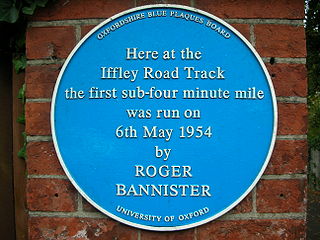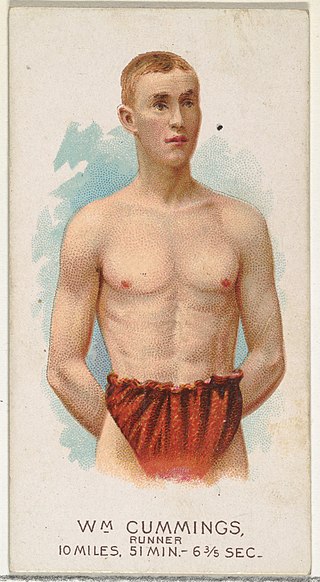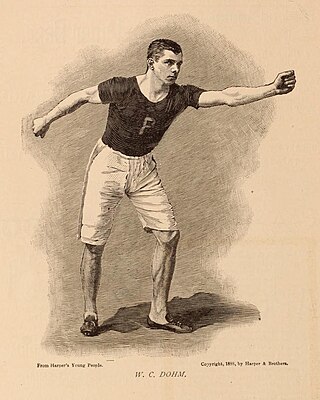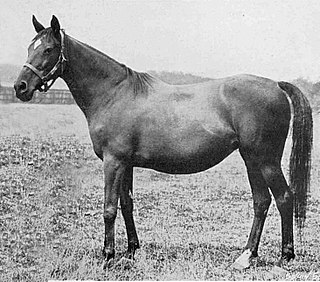Related Research Articles

Sir John George Walker, is a former middle-distance runner from New Zealand who won the gold medal in the men's 1500 m event at the 1976 Olympics. He was also the first person to run the mile in under 3:50. In more recent years, Walker has been active in local government, as an Auckland Councillor and representing the Manurewa-Papakura ward.

A four-minute mile is the completion of a mile run in four minutes or less. It was first achieved in 1954 by Roger Bannister, at age 25, in 3:59.4, although this is disputed. As of June 2022, the "four-minute barrier" has been broken by 1,755 athletes, and is now a standard of professional middle distance runners in several cultures. In the decades since, the mile record has been lowered by 16 seconds, and currently stands at 3:43.13, by Hicham El Guerrouj of Morocco, at age 24, in 1999. Running a mile in four minutes translates to a speed of 15 miles per hour (24 km/h).
Brigadier Gerard was a British Thoroughbred racehorse and sire. In a racing career which lasted from June 1970 until October 1972, he won seventeen of his eighteen races. The colt is rated the best racehorse trained in Britain in the 20th century.
The world record in the mile run is the fastest time set by a runner in the middle-distance track and field event. World Athletics is the official body which oversees the records. Hicham El Guerrouj is the current men's record holder with his time of 3:43.13, while Faith Kipyegon has the women's record of 4:07:64. Since 1976, the mile has been the only non-metric distance recognized by the IAAF for record purposes. However, in international competitions such as the Olympics the term "mile" almost always refers to a distance of 1,500 meters, which is 109.344 meters shorter than an Imperial mile, even though four "full" laps of a 400 meter track is equal to 1,600 meters.

Newmarket Racecourse is a British Thoroughbred horse racing venue in Newmarket, Suffolk, comprising two individual racecourses: the Rowley Mile and the July Course. Newmarket is often referred to as the headquarters of British horseracing and is home to the largest cluster of training yards in the country and many key horse racing organisations, including Tattersalls, the National Horseracing Museum and the National Stud. Newmarket hosts two of the country's five Classic Races – the 1,000 Guineas and 2,000 Guineas, and numerous other Group races. In total, it hosts 9 of British racing's 36 annual Group 1 races.

William J. Cummings was a Scottish professional runner who held the record for the mile in the 19th century and is perhaps best remembered for a series of races against Walter George, a top amateur runner who turned professional in part to challenge Cummings.

Walter Goodall George was a nineteenth-century British runner from Calne who after setting numerous world records as an amateur, went professional in part to challenge the mile record-holder William Cummings, defeating him in several highly publicized races. In one of those races on 23 August 1886, he set a mile record which was not surpassed for almost 30 years.
Siah Albison (1840–1891) was a professional British runner who set a world record in the mile in the 1860s.

The 1500-metre run became a standard racing distance in Europe in the late 19th century, perhaps as a metric version of the mile, a popular running distance since at least the 1850s in English-speaking countries.

Dutch Oven (1879–1894) was a British Thoroughbred mare that won the 1882 St. Leger Stakes. Raced extensively as a two-year-old, she won nine races and £9429, but her form faltered in her late three and four-year-old seasons. Retired in 1884, Dutch Oven was not considered to be a success in the stud, but her offspring exported to Australia and Argentina did produce successful racehorses.
James Nuttall was a professional British runner, who broke several records, and is regarded as "one of the best sprinters and quarter milers in England in the 1860s". During his thirteen-year career, Nuttall ran 440 yards in 51.5 seconds, and ran the half-mile in a world’s best time of 1:55.5.
Owen Tudor (1938–1966) was a British Thoroughbred racehorse and sire. In a career that lasted from 1940 to 1942 he ran twelve times and won six races. His most important win came as a three-year-old in the summer of 1941 when he won the "New Derby" at Newmarket. During the Second World War many British racecourses were closed either for safety reasons or because the land was needed for military use. Epsom Downs Racecourse was used throughout the war for an anti-aircraft battery, leading to the creation of a substitute or "New" version of the race. Owen Tudor went on to win a substitute "Ascot Gold Cup" at Newmarket in 1942. At the end of that season he was retired to stud where he had considerable success as a sire of winners.

Lord Lyon (1863–1887) was a British Thoroughbred racehorse that won the 1866 Epsom Derby, 2,000 Guineas Stakes and the St. Leger Stakes, becoming the third winner of the English Triple Crown. Lord Lyon raced until he was four-years old and was retired to stud in 1868. He is considered to be a marginally successful sire with his most notable progeny being the colt Minting and the filly Placida. He was euthanized in April 1887 after several years of failing health.

Gemma Steel is a British long-distance runner who competes in road running and cross country running competitions. She was the 2014 gold medallist at the European Cross Country Championships. She has represented Great Britain internationally in cross country, road and track events. She has won at three of the Great Run series events: the Great Ireland Run, Great Birmingham Run and Great Yorkshire Run. She has also won the Bristol Half Marathon and placed seventh at the 2012 IAAF World Half Marathon Championships.

Walter Charles Dohm was an American track and field athlete. Dohm won national and intercollegiate championship titles at both 440 yards and 880 yards and set a world record at the latter distance in 1891.
The Sir Walter Miler is an outdoor one mile race held annually at Meredith College in Raleigh North Carolina, typically the first Friday in August. The race is named after Sir Walter Raleigh. It is directed and promoted by Sir Walter Running, a Raleigh-based 501(c)(3) non-profit organization. A hallmark of the race is the close proximity of fans to the track, as spectators gather on the infield and in the outer lanes of the track to watch the races.

La Roche was a British Thoroughbred racehorse and broodmare. As a two-year-old in 1899 she showed some promise, winning once from six attempts, but appeared to be some way below top class. In the following season, when tried over longer distance, she emerged as one of the best horses of her generation in England, winning the Oaks Stakes, Manchester Cup, Yorkshire Oaks and Newmarket Oaks as well as finishing fourth in the 1000 Guineas and third in the Doncaster Cup. She was retired at the end of the season to become a broodmare and had considerable success as a dam of winners.

Isla Bonita is a Japanese Thoroughbred racehorse and sire. As a juvenile in 2013 he showed very promising form as he won three of his four races including the Icho Stakes and the Tokyo Sports Hai Nisai Stakes. In the following year he took the JRA Award for Best Three-Year-Old Colt after winning the Kyodo Tsushin Hai, Satsuki Sho and St Lite Kinen as well as finishing second in the Tokyo Yushun and third in the autumn edition of the Tenno Sho. He failed to win in the net two years but ran well in several major races, being placed in the Tenno Sho and two runnings of the Mile Championship. In his final season he returned to winning form, taking the Yomiuri Milers Cup and the Hanshin Cup.

The 10-mile run is a long-distance running event over a distance of ten miles (16.1 kilometres). It can be held on a road course or on a running track. Also referred to as a 10-miler or 10 miles run, it is a relatively common distance in countries that use the mile as a unit of measure. Ten miles is roughly an intermediate distance between the 10K run and the half marathon (21.1 km). The level of endurance required to run the distance means it attracts more seasoned runners than shorter events and usually requires a period of preparation for first-time attempts.

Kameko is an American-bred, British-trained Thoroughbred racehorse. As a two-year-old in 2019 he won his first race and then ran second in both the Solario Stakes and the Royal Lodge Stakes before winning the Vertem Futurity Trophy. On his first appearance as a three-year-old he won the 2000 Guineas in record time. He went on to win the Joel Stakes and finished fourth in both the Sussex Stakes and the International Stakes before being retired to stud at the end of the year.
References
- 1 2 3 4 "PEDESTRIANISM.--Lang v. Time". The Yorkshire Herald and the York Herald. 7 November 1863. p. 12. Retrieved 21 January 2024.
- 1 2 3 "PEDESTRIANISM AT NEWTON HEATH". The Guardian. 19 June 1865. p. 4. Retrieved 21 January 2024.
- ↑ "GREAT MILE RACE AT MANCHESTER". Birmingham Daily Post. 16 January 1865. p. 8. Retrieved 21 January 2024.
- ↑ "MILE RACE FOR THE CHAMPIONSHIP AT MANCHESTER". Sheffield and Rotherham Independent. 16 January 1865. p. 3. Retrieved 21 January 2024.
- ↑ "EXCITING AND INTERESTING MILE FOOT RACE". Manchester Weekly Times and Examiner. 2 July 1864. p. 7. Retrieved 21 January 2024.
- ↑ "UNPRECEDENTED PEDESTRIAN MILE RACE AT NEWMARKET ON FRIDAY MORNING". The Guardian Journal. 31 October 1863. p. 8. Retrieved 21 January 2024.
- 1 2 "Pedestrianism at Manchester". The Era. 22 January 1865. p. 4. Retrieved 21 January 2024.
- ↑ "PEDESTRIANISM". The Australian Town and Country Journal. 14 January 1882. p. 33. Retrieved 21 January 2024.
- ↑ "Sports Fallacies by Margery Miller". The Herald-Press. 6 April 1946. p. 7. Retrieved 21 January 2024.
- ↑ "LANG AND SANDERSON". The Era. 18 June 1865. p. 5. Retrieved 21 January 2024.
- Cordner Nelson and Roberto Quercetani, The Milers, Tafnews Press, 1985, ISBN 0-911521-15-1, pp. 1–3
- Edward Seldon Sears, Running Through the Ages, Mcfarland, 2001, ISBN 0-7864-0971-1, pp. 112–3